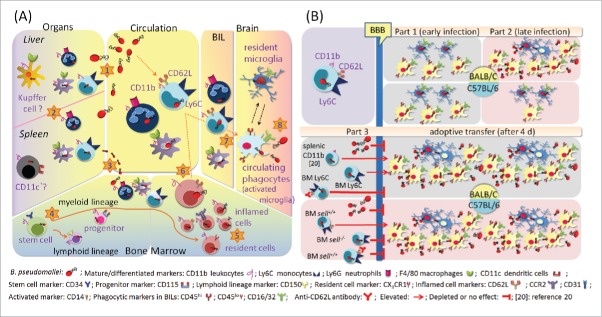Figure 8.
Summary of Trojan horse mechanism (A). During melioidosis, microabscesses develop secondary to primary foci via hematogenous routes (step 1), and B. pseudomallei steadily persists in CD11b+Ly6C+ monocytes, CD11b+Ly6G+ neutrophils and CD11b+F4/80+ macrophages in the liver and spleen (step 2). After 4 d of infection, the bacteremia could disappear, but the liver and spleen become B. pseudomallei reservoirs. Once bacteremia recurs or persists (step 3), B. pseudomallei invades CD11b+CD34+ stem cells and CD11b+CD115+ phagocytic progenitors and differentiated CD11b+Ly6C+ monocytes, CD11b+Ly6G+ neutrophils, CD11b+F4/80+ macrophages and activated CD11b+CD14+ LPS-responding cells, as well as lymphoid–lineage CD11b+CD150+ cells in the BM (step 4). Prior to emigration, the inflamed CD11b+CCR2+, CD11b+CD62L+ and CD11b+CD31+ BM cells harboring B. pseudomallei mature (step 5). On d 21 post-infection, the inflamed Ly6C+CD62L+GFP+ cells become a predominant B. pseudomallei-loaded subpopulation, and the circulating monocyte-derived CD11b+Ly6C+ and CD11b+F4/80+ cells harboring B. pseudomallei are expanded (step 6). Acting as a Trojan horse, the infected Ly6C+CD62L+ cells cross the cerebral endothelium via selectin-mediated leukocyte migration, resulting in expansion of the circulating CD16/32+CD45hi phagocytes in the BILs (step 7) and eventual B. pseudomallei colonization of the brain (step 8). Comparison of BALB/c and C57BL/6 mice with melioidosis (B). During early infection (by d 4 post-infection), the circulating CD16/32+CD45hiGFP+ phagocytes rapidly infiltrate the brains of C57BL/6 and BALB/c mice; however, the growth of intracellular B. pseudomallei is restricted (Part 1). On d 14 post-infection (during late infection), CD16/32+CD45loGFP+ microglia are expanded in the BILs in both BALB/c and C57BL/6 mice with melioidosis. However, in BALB/c mice with melioidosis, the CD16/32+CD45hiGFP+ phagocytes are rapidly expanded in the BILs, eventually resulting in the growth of B. pseudomallei in the brain. However, CD16/32+CD45hiGFP+ phagocytes are rarely found in C57BL/6 mice, and consequently, B. pseudomallei has difficultly colonizing C57BL/6 brains (Part 2). After adoptive transfer of B. pseudomallei-loaded splenic CD11b cells (see reference 20) or BM Ly6C cells, the bacterial loads in the recipient BALB/c brains increase. In contrast, the bacterial loads in the C57BL/6 recipient brains are decreased after adoptive transfer of sell-/- Ly6C cells compared to adoptive transfer of sell+/+ Ly6C cells. When anti-CD62 antibody-treated Ly6C cells infected with B. pseudomallei act as donors, bacterial colonization of recipient BALB/c and C57BL/6 brains is also depleted. Besides, bacterial colonization of both BALB/c and C57BL/6 brains is not induced by intravenous injection of free B. pseudomallei (Part 3).

